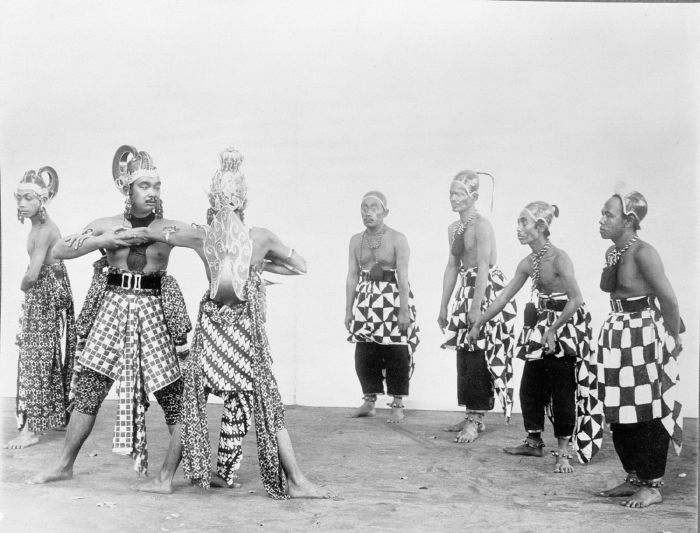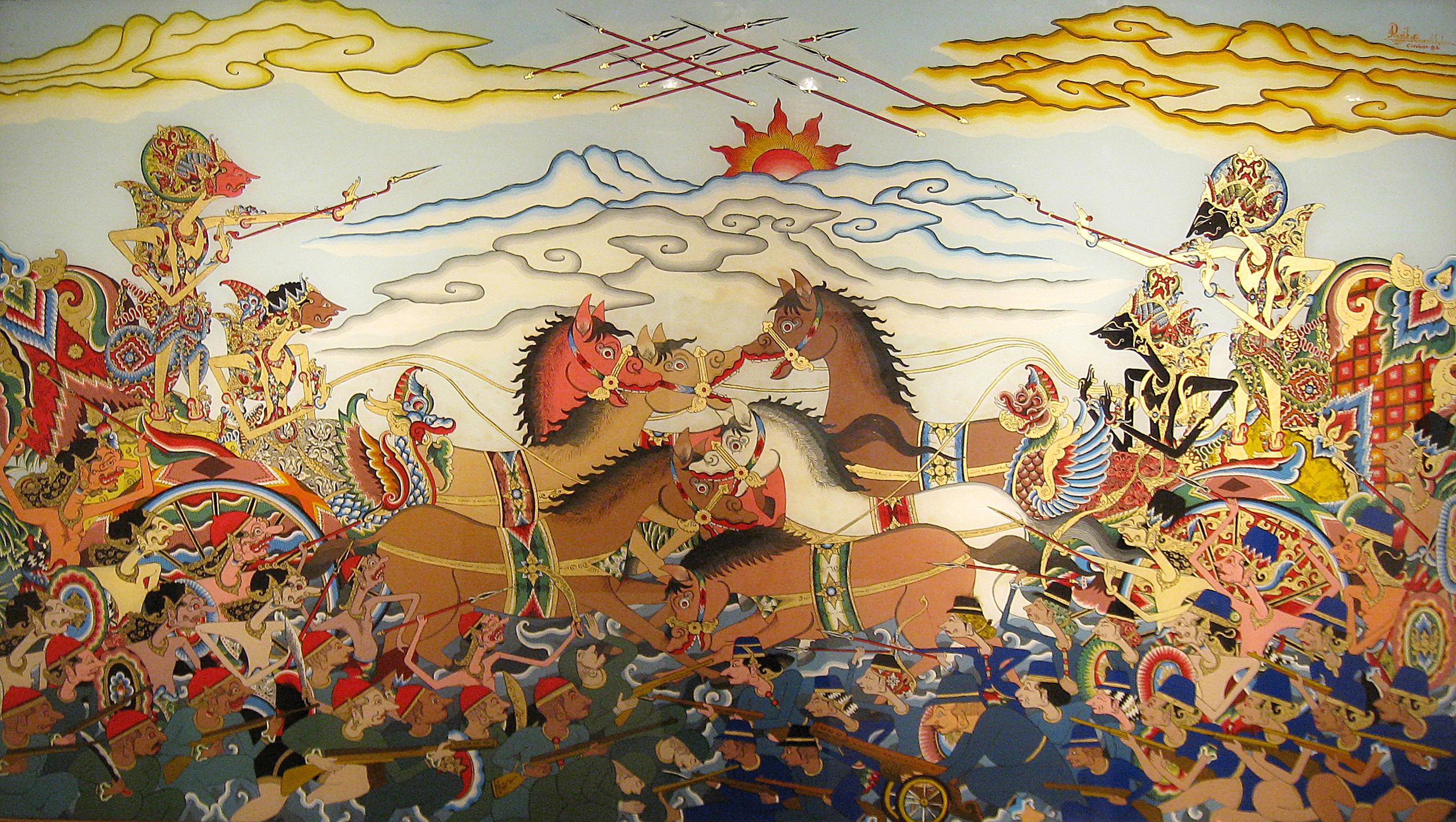|
Punakawan
In Javanese ''wayang'' (shadow puppets), the ''panakawan'' or ''panakavan'' (''phanakavhan'') are the clown servants of the hero. There are four of them – ''Semar'' (also known as ''Ki Lurah Semar''), ''Petruk'', '' Gareng'' and '' Bagong''. ''Semar'' is the personification of a deity, sometimes said to be the ''dhanyang'' or guardian spirit of the island of Java. In Javanese mythology, deities can only manifest themselves as ugly or otherwise unprepossessing humans, and so ''Semar'' is always portrayed as short and fat with a pug nose and a dangling hernia. His three companions are his adopted sons, given to ''Semar'' as votaries by their parents. ''Petruk'' is portrayed as tall and gangling with a long nose, ''Gareng'' as short with a club foot and ''Bagong'' as obese. The panakawan always appear in the second act of a wayang performance – ''pathet sanga'' – as servants to the hero of the story regardless of who that hero is. Similar characters appear in other Indonesia ... [...More Info...] [...Related Items...] OR: [Wikipedia] [Google] [Baidu] |
Wayang
, also known as ( jv, ꦮꦪꦁ, translit=wayang), is a traditional form of puppet theatre play originating from the Indonesian island of Java. refers to the entire dramatic show. Sometimes the leather puppet itself is referred to as . Performances of wayang puppet theatre are accompanied by a ''gamelan'' orchestra in Java, and by '' gender wayang'' in Bali. The dramatic stories depict mythologies, such as episodes from the Hindu epics the ''Ramayana'' and the ''Mahabharata'', as well as local adaptations of cultural legends. Traditionally, a is played out in a ritualized midnight-to-dawn show by a ''dalang'', an artist and spiritual leader; people watch the show from both sides of the screen. performances are still very popular among Indonesians, especially in the islands of Java and Bali. performances are usually held at certain rituals, certain ceremonies, certain events, and even tourist attractions. In ritual contexts, puppet shows are used for prayer rituals (held in ... [...More Info...] [...Related Items...] OR: [Wikipedia] [Google] [Baidu] |
Petruk
Petruk is a character in traditional Javanese puppetry, or ''wayang''. He is one of the ''Punokawan'', four comedic figures common in the medium. Depiction Petruk is one of the four ''Punokawan'', together with Semar (the leader/father figure), Bagong, and Gareng; Petruk acts as the middle child. They are portrayed living together as a harmonious family. The Punokawan, often referred to as clowns in English, provide comic relief in the stories they are in, but also serve to speak to the audience and convey ideas of the ''dhalang'' (puppeteer), including social criticism. Petruk is depicted as having lengthy limbs and a long nose; his nose is generally considered his most distinctive feature. In ''wayang'' performances the ''dhalang'' generally provides a "warrior's voice" for Petruk, as opposed to the nasal voice used for his brothers. He is married to Dewi Ambarawati, whom he won the right to marry after defeating four other suitors in a vicious battle. Together they have a s ... [...More Info...] [...Related Items...] OR: [Wikipedia] [Google] [Baidu] |
Wayang
, also known as ( jv, ꦮꦪꦁ, translit=wayang), is a traditional form of puppet theatre play originating from the Indonesian island of Java. refers to the entire dramatic show. Sometimes the leather puppet itself is referred to as . Performances of wayang puppet theatre are accompanied by a ''gamelan'' orchestra in Java, and by '' gender wayang'' in Bali. The dramatic stories depict mythologies, such as episodes from the Hindu epics the ''Ramayana'' and the ''Mahabharata'', as well as local adaptations of cultural legends. Traditionally, a is played out in a ritualized midnight-to-dawn show by a ''dalang'', an artist and spiritual leader; people watch the show from both sides of the screen. performances are still very popular among Indonesians, especially in the islands of Java and Bali. performances are usually held at certain rituals, certain ceremonies, certain events, and even tourist attractions. In ritual contexts, puppet shows are used for prayer rituals (held in ... [...More Info...] [...Related Items...] OR: [Wikipedia] [Google] [Baidu] |
Javanese Mythology
The mythology of Indonesia is very diverse, the Indonesian people consisting of hundreds of ethnic groups, each with their own myths and legends that explain the origin of their people, the tales of their ancestors and the demons or deities in their belief systems. The tendency to syncretize by overlying older traditions with newer foreign ideas has occurred. For example, the older ancestral mythology might be merged with foreign mythology, such as Hindu, Islam, or Christian biblical mythology. Foreign influences Some native Indonesian ethnic groups that were isolated from the rest of the world until recent centuries have their own native myths and gods. These native mythologies are relatively free from foreign influences, such as Torajans, Nias, Bataks, Dayaks and Papuans. By contrast, Javanese, Balinese,and Sundanese were influenced by Hindu-Buddhist Indian mythology as early as the 1st century CE. Hindu gods, legends and epics such as ''Ramayana'' and ''Mahabharata'' wer ... [...More Info...] [...Related Items...] OR: [Wikipedia] [Google] [Baidu] |
Javanese Culture
Javanese culture is the culture of the Javanese people. Javanese culture is centered in the provinces of Central Java, Yogyakarta and East Java in Indonesia. Due to various migrations, it can also be found in other parts of the world, such as Suriname (where 15% of the population are of Javanese descent), the broader Indonesian archipelago region, Cape Malay, Malaysia, Singapore, Netherlands and other countries. The migrants bring with them various aspects of Javanese cultures such as music, traditional dances and art of shadow play. The migration of Javanese people westward has created the coastal Javanese culture that is distinct from inland Sundanese culture in West Java and Banten. Being the largest ethnic group, the Javanese culture and people influence Indonesian politics and culture, a process sometimes described as Javanisation. Literature Javanese literature tradition is among the earliest and the oldest surviving literature traditions in Indonesia. The transla ... [...More Info...] [...Related Items...] OR: [Wikipedia] [Google] [Baidu] |
Semar
Semar is a character in Javanese mythology who frequently appears in wayang shadow plays. He is one of the punokawan (clowns), but is in fact divine and very wise. He is the dhanyang (guardian spirit) of Java,Geertz, 23. and is regarded by some as the most sacred figure of the wayang set. Holt, 144. He is said to be the god Sang Hyang Ismaya in human form.Budihardja, "Grepen uit de Wajang," ''Djawa'' II (1922), 22-23; cited in Holt, 145. The name Semar is said to derive from the Javanese word ''samar'' ("dim, obscure, mysterious"). He is often referred to with the honorific, "Kyai Lurah Semar" ("the venerable chief"). Description In depictions, Semar appears with a flat nose, a protruding lower jaw, a tired eye, and bulging rear, belly, and chest. He wears a checkered hipcloth, symbolizing sacredness. Like the other panakawan, the wayang kulit puppet does not have the elaborate openwork and ornamentation characteristic of the heroes In wayang wong, Semar always leans forwa ... [...More Info...] [...Related Items...] OR: [Wikipedia] [Google] [Baidu] |
Pathet Sanga
Pathet ( jv, ꦥꦛꦼꦠ꧀, translit=Pathet, also patet) is an organizing concept in central Javanese gamelan music in Indonesia. It is a system of tonal hierarchies in which some notes are emphasized more than others. The word means '"to damp, or to restrain from" in Javanese. ''Pathet'' is "a limitation on the player's choice of variation, so that while in one ''pathet'' a certain note may be prominent, in another it must be avoided, or used only for special effect. Awareness of such limitations, and exploration of variation within them reflects a basic philosophical aim of gamelan music, and indeed all art in central Java, namely, the restraint and refinement of one's own behaviour." Javanese often give poetic explanations of pathet, such as "Pathet is the couch or bed of a melody." In essence, a pathet indicates which notes are stressed in the melody, especially at the end of phrases (seleh), as well as determines which elaborations (cengkok and sekaran) are appropriate. I ... [...More Info...] [...Related Items...] OR: [Wikipedia] [Google] [Baidu] |
Bali
Bali () is a province of Indonesia and the westernmost of the Lesser Sunda Islands. East of Java and west of Lombok, the province includes the island of Bali and a few smaller neighbouring islands, notably Nusa Penida, Nusa Lembongan, and Nusa Ceningan to the southeast. The provincial capital, Denpasar, is the most populous city in the Lesser Sunda Islands and the second-largest, after Makassar, in Eastern Indonesia. The upland town of Ubud in Greater Denpasar is considered Bali's cultural centre. The province is Indonesia's main tourist destination, with a significant rise in tourism since the 1980s. Tourism-related business makes up 80% of its economy. Bali is the only Hindu-majority province in Indonesia, with 86.9% of the population adhering to Balinese Hinduism. It is renowned for its highly developed arts, including traditional and modern dance, sculpture, painting, leather, metalworking, and music. The Indonesian International Film Festival is held every year in Bal ... [...More Info...] [...Related Items...] OR: [Wikipedia] [Google] [Baidu] |
West Java
West Java ( id, Jawa Barat, su, ᮏᮝ ᮊᮥᮜᮧᮔ᮪, romanized ''Jawa Kulon'') is a province of Indonesia on the western part of the island of Java, with its provincial capital in Bandung. West Java is bordered by the province of Banten and the country's capital region of Jakarta to the west, the Java Sea to the north, the province of Central Java to the east and the Indian Ocean to the south. With Banten, this province is the native homeland of the Sundanese people, the second-largest ethnic group in Indonesia. West Java was one of the first eight provinces of Indonesia formed following the country's independence proclamation and was later legally re-established on 14 July 1950. In 1966, the city of Jakarta was split off from West Java as a 'special capital region' (), with a status equivalent to that of a province, while in 2000 the western parts of the province were in turn split away to form a separate Banten province. Even following these split-offs, West Java is ... [...More Info...] [...Related Items...] OR: [Wikipedia] [Google] [Baidu] |


_TMnr_809-45b.jpg)





